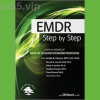EMDR: Step by Step: New In-Session Demonstrations by Bessel Van der Kolk , Peter Levine & others – PESI
$199.00 Original price was: $199.00.$23.10Current price is: $23.10.
EMDR: Step by Step: New In-Session Demonstrations – Digital Download!

EMDR: Step by Step: New In-Session Demonstrations by Bessel Van der Kolk , Peter Levine & others – PESI
Overview

EMDR: Step by Step: Practical In-Session Demonstrations
The program titled “EMDR: Step by Step: Practical In-Session Demonstrations” offers mental health professionals an in-depth look at Eye Movement Desensitization and Reprocessing (EMDR) therapy, with a specific focus on trauma treatment. Led by renowned experts like Bessel van der Kolk and Peter Levine, the course bridges the gap between theory and hands-on practice. Designed to enhance clinical skills and prioritize client safety, the training helps practitioners effectively support the complex needs of those affected by trauma.
Tailored for clinicians, this course covers practical applications of EMDR techniques in a simple, structured format. Participants are guided through multiple in-session demonstrations, helping reinforce theoretical concepts while also providing real-world examples to enhance their learning experience. Facilitated by trauma therapy expert Linda Curran, the program covers foundational EMDR skills as well as more advanced therapeutic strategies.
Key Foundations of EMDR Therapy
The course begins with the essential elements that form the basis of EMDR therapy. Participants will explore critical topics such as the prerequisites for EMDR, strategies for effective communication, and methods for grounding clients during sessions. A major objective of the course is to improve clinical assessment skills, ensuring that client safety and stability are maintained during the processing of traumatic memories.
• Essentials for EMDR Therapy: Understanding the basic skills needed to apply EMDR is essential for successful practice. The course offers a comprehensive guide to these foundational techniques.
• Communicating EMDR Principles: Instructors emphasize the importance of clearly explaining EMDR’s core theories to clients, helping them feel more at ease throughout the therapeutic journey.
• Techniques for Grounding Clients: The course highlights the importance of grounding methods to ensure clients remain secure when confronting distressing content, fostering therapeutic trust and effectiveness.
These foundational elements lay the groundwork for understanding the eight phases of EMDR’s standard protocol, which is a crucial part of guiding therapists through a safe and effective therapeutic process.
Hands-On Demonstrations in Practice
One of the most valuable components of the “EMDR: Step by Step” program is the inclusion of real-world case studies and in-session demonstrations, led by skilled therapists. Participants get the opportunity to observe how seasoned clinicians manage trauma processing challenges in real-time. These demonstrations are valuable for several reasons:
• Learning Through Observation: Clinicians can watch live case studies, offering a clear view of how theoretical concepts translate into practice.
• Insights into Effective Intervention: Observers gain practical insights into various intervention techniques, equipping them with strategies to foster successful therapeutic outcomes for their clients.
The Value of Real-World Application
The inclusion of real-world demonstrations highlights the importance of hands-on learning in trauma therapy. These demonstrations provide clear examples of how trauma content is managed, showing therapists how to guide clients through their healing journey effectively.
Expert Guidance and Contributions
Dr. Bessel van der Kolk’s research plays a pivotal role in this training, focusing on the mind-body connection in trauma recovery. His work challenges the belief that traditional talk therapies are sufficient for all trauma clients and promotes EMDR as a more efficient method. Course materials stress EMDR’s unique ability to help individuals process traumatic memories without relying heavily on verbal recounting, thereby reducing the emotional burden on clients.
Client Safety Protocols in EMDR Therapy
During trauma memory processing, clients often experience significant discomfort. The course emphasizes the importance of safety protocols to help minimize distress and create a supportive environment for healing. These protocols are crucial to ensuring that clients feel supported during each session, which is integral to achieving positive therapeutic outcomes.
• Managing Distress in Clients: Therapists are taught practical strategies to counteract client distress, including:
• Creating a Safe Environment: Clinicians learn how to establish an atmosphere where clients feel both safe and respected.
• Pre-Session Preparation: By informing clients about what to expect, anxiety is reduced, and clients gain a greater sense of control over their process.
• Post-Session Support: Aftercare guidance helps clients integrate their experiences, allowing them to maintain emotional stability.
These strategies not only enhance the therapeutic experience but also ensure that clients feel safe and supported, a critical aspect when working with trauma.
Improving Clinical Competencies Through EMDR
The “EMDR: Step by Step” program is structured to improve clinicians’ skill sets through a mix of theoretical knowledge and hands-on demonstrations. By participating in this training, therapists are equipped with the tools they need to provide trauma treatment effectively.
• Assessing Clients and Ensuring Safety: A central focus of the program is strengthening clinical assessment skills. Practitioners learn how to determine the right time and method for applying EMDR techniques. This ensures that therapy is both effective and attuned to each client’s individual experience of trauma.
• Assessment Tools for Trauma: The course introduces several tools and strategies for assessing the impact of trauma and determining when a client is ready for EMDR.
• Continuous Client Feedback: Therapists are encouraged to integrate feedback throughout the therapy process, allowing them to adapt as needed.
• Implementing Trauma-Informed Care: The training emphasizes the importance of integrating trauma-informed care into practice, enhancing therapy’s overall effectiveness.
By honing these skills, clinicians are better prepared to provide compassionate, effective trauma therapy that respects clients’ boundaries.
Final Thoughts
In conclusion, the “EMDR: Step by Step: New In-Session Demonstrations” program stands as an invaluable resource for clinicians aiming to enhance their expertise in trauma therapy. With insights from leading experts, practical sessions, and a focus on client safety, this training offers a thorough approach to mastering EMDR. By combining theory with hands-on practice, therapists are well-prepared to create meaningful therapeutic relationships and make a lasting impact on their clients’ healing journeys. This program sets a new standard in trauma therapy and ensures that clinicians are equipped to meet the complex needs of their clients while advancing the effectiveness of trauma treatment.
Frequently Asked Questions:
Business Model Innovation: We operate a group buying strategy, allowing participants to share costs and access popular courses at reduced prices. This model benefits individuals with limited financial resources, despite concerns from content creators about distribution methods.
Legal Considerations: The legality of our operations involves complex issues. Although we don’t have explicit permission from course creators to resell their content, there are no specific resale restrictions stated at the time of purchase. This ambiguity creates an opportunity for us to provide affordable educational resources.
Quality Control: We ensure that all course materials purchased are identical to those offered directly by the creators. However, it’s important to understand that we are not official providers. As such, our offerings do not include:
– Live coaching calls or sessions with the course author.
– Access to exclusive author-controlled groups or portals.
– Membership in private forums.
– Direct email support from the author or their team.
We aim to reduce the cost barrier in education by offering these courses independently, without the premium services available through official channels. We appreciate your understanding of our unique approach.
Be the first to review “EMDR: Step by Step: New In-Session Demonstrations by Bessel Van der Kolk , Peter Levine & others – PESI” Cancel reply
You must be logged in to post a review.

















Reviews
There are no reviews yet.